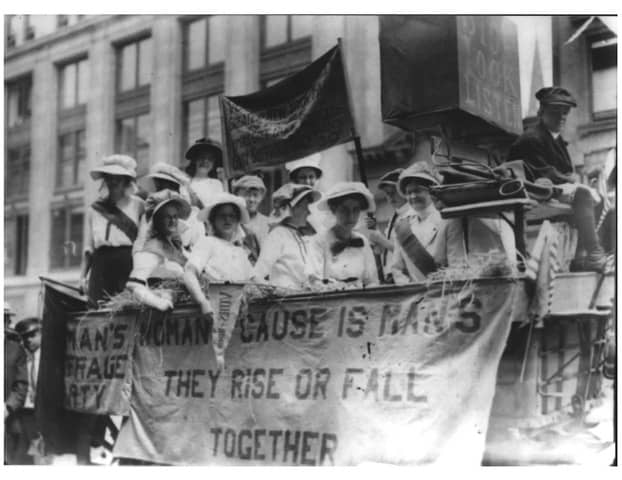
Yonkers Suffragists in 1913 on a float in Getty Square. They were on their way to a meeting with Mayor Lennon to show him their float. After that meeting, they headed to the August 1913 NY Suffrage Parade in Manhattan.The banner reads, “Woman’s cause is man’s, they rise or fall together”.
By Mary Hoar, City of Yonkers Historian, President Emerita of the Yonkers Historical Society, Recipient of the Key to History, Key to the City of Yonkers, and President of the Untermyer Performing Arts Council
Samuel Untermyer was a proponent of Women’s Suffrage and Women’s Rights long before Minnie embraced this side of the struggle; in fact, she worked against women voting. In 1908 Mrs. Untermyer was elected Vice President of the League for the Civic Education of Women; members of this organization, some of New York’s most prominent families, were “vowed enemies of woman suffrage.”[i] Their battle cry was “Women of America, your attention please. Don’t be deluded into believing you should be allowed to vote. Equal suffrage leads to an unseen peril.”[ii]
That December the New York Times reported Mrs. Samuel Untermyer attended a League meeting held at the Berkeley Lyceum; the audience was almost totally comprised mostly of women, with only 5 or 6 men in attendance. A letter from President Roosevelt was read, a letter that began, “Personally I believe in woman’s suffrage but I am not an enthusiastic advocate of it because I do not regard it as a very important matter.”[iii]
Minnie must have had serious second thoughts because a few weeks later she shared the stage with other society matrons, including Samuel’s competitor J. P. Morgan’s daughter Anne, at a Cooper Union pro-Suffrage rally. The Presidents of the Woman’s Trade Union, the Central Federated Union and the Brooklyn Labor Union also were on the platform.[iv]
Women’s rights, particularly the right to vote, had become a joint project of New York Society and the American Labor movement.
The New York World announced Minnie’s change of heart with the headline “Suffrage Gains Pair of Noted Women Converts;” her attendance at a Westchester Suffrage meeting had caught the reporter’s interest. She “…frankly confessed she had resigned as vice president of the League for the Civic Education of Women… and was going to join both of the leading suffrage societies of New York.”[v] Minnie outlined her plan to advance the suffrage cause; she would hold a meeting at Greystone, with speakers being “…working girl suffragists instead of the ‘upper tenners.”[vi] Samuel, who “…had always been a suffragist,”[vii] would be happy to preside at the meeting.
After New York elite came out in force for Women’s Suffrage, meetings and fundraising events became elegant receptions, such as for the Equal Franchise Society. Held at the home of its President Marie Louise Mackay in a home decorated with flowers and palms, the entertainment was provided by Nathan Franko’s orchestra; three society hostesses poured tea for the guests.[viii]
New York Society became involved with the rights of factory working girls, particularly during the shirtwaist maker strike. Thirty-thousand female workers were trying to improve their deplorable working conditions; two hundred fifty-one companies had settled, but the leadership of the employers’ organization refused to reach an accord. Instead they called the police to arrest the picketers.
“The Rich Out to Aid Girl Waistmakers—Carnegie Hall Packed at Protest Meeting Against the Arrest of Their Pickets”[ix] read the New York Times headlines. The article continued, “Fifth Avenue and the lower east side, both represented chiefly by women and girls, joined last night in filling Carnegie Hall to protest against… the continued encroachment of the police… upon the rights of the striking shirtwaist makers and their sympathizers.”[x] Along with the Untermyers, other prominent society names in the concert hall boxes were Belmont, Morgan, Sage, Hay, Gillespie, Straus and Laidlaw.
Mrs. Oliver Belmont was one society member who “put her money where her mouth is.” The arrested pickets were thrown into the notorious Blackwell’s Island prison for what witnesses said were no offences. Recognizing the injustice, Mrs. Belmont offered to guarantee their bail with some properties she owned. When the girls finally appeared in court, the Belmont lawyer, who had been kept waiting all night, with the deeds, could not be found. The society matron put her Madison Avenue townhouse up as security instead.[xi]
National figures began throwing their influence behind the campaign, guaranteeing large attendance at the 1913 New York City Suffrage Parade. A weekend affair, it began with an evening pageant at the Metropolitan Opera House. The standing room only audience watched a pageant presented by a consortium of Suffrage societies, followed with an address by former President Theodore Roosevelt. The topic of his speech was the importance of granting women the right to vote, a change from his stance a few years earlier.
Labor union members, horsemen and horsewomen, women driving cars, Boy Scouts, teachers and students, doctors, lawyers, architects, and many other professionals, joined members of suffrage organizations from all over the country. Thousands marched to the sounds of 35 bands, all to show support for women’s suffrage. The parade grandstand was filled with husbands of the prominent society women in the parade. New York State Governor Charles Whitman sat next to Samuel Untermyer; both men proudly watching their wives march.[xii]
Samuel passionately testified in Albany for women’s rights. In February 1910, he pleaded the cause of woman suffragists before the New York State Judiciary Committee.[xiii] Three months later, he again was in Albany, making a moving testimony during Woman’s Suffrage Week hearings. Immediately following the presentations of the anti-suffrage speakers, Mr. Untermyer was the first to speak on behalf of women’s right to vote. Mr. Untermyer reviewed the history of the movement in this country and continued:
‘In every great controversy for freedom the law has always been in the wrong… This is particularly true of the present movement that strikes at the root of the social fabrics and seeks to give representation to that half of our citizens who bear their share of the duties and responsibilities of civilized life and of government.
“Women are eligible with men for the electric chair, the prison, and the tax roll. In seems intolerable that they should be ineligible for the ballot, the jury box, and to have their part in framing the laws under which they are required to live.
“But we are told that whatever may have been the injustice of the past, the law now deals justly with women, and that they have no grievance which requires so radical an innovation as the experiment of the ballot to correct. Such an argument takes no account of the unanswerable justice of their demand.
“Do women receive fair or decent consideration from the courts in the way of support where they are deserted by their husbands or are compelled for other reasons to seek divorce?
“The result is that she and her children are invariably punished for the man’s offense. The law seems to proceed on the utterly intolerable and indefensible theory that the wife has no interest in the property accumulated during marriage…
The law does not give to the wife as a right any part of the husband’s estate in case of his death unless he happens to own land. He can leave her penniless if he sees fit.”[xiv]
Samuel began actively working on Men’s League for Woman Suffrage events[xv] and was a frequent speaker at fundraisers and meetings.[xvi] Untermyer volunteered to represent British militant suffragist Emmeline Pankhurst when the US government tried to deport her. Although he did not officially present her cause to President Wilson, Minnie and Samuel sat at the head table for her first speech in the U.S. after the President reversed the decision of the Immigration Board of Special Inquiry.
The Untermyers actively began their own round of education, entertaining and fundraising. Making good on Minnie’s 1909 promise of letting the factory workers tell the story of their lives, the Untermyers gathered a group of 60 society and community leaders at Greystone to hear addresses by striking shirtwaist makers. Samuel told the crowd he hoped the “…girls would win and assured them of his sympathy.”[xvii]
Minnie was patroness of two theatrical benefits in March 1910 to raise money to benefit suffrage.[xviii] Shortly afterwards she banded together with Mrs. Vanderbilt, Mrs. Whitney, Mrs. Russell Sage and other women to publish their names as members of the Woman Suffrage Party. These ladies all lived in the same Assembly District and publicly contradicted Assemblyman Dana who claimed no one in his district supported suffrage, and that only one of his female constituents wanted to vote.[xix]
That June, Greystone was opened to reformers with the first of a series of Hudson River Equal Franchise Society’s drawing room lectures. Attendees included both husbands and wives of society’s elite, and, it was noted, Mrs. Louis Myers, Samuel and Minnie’s daughter Irene. [xx]
A “Votes for Women” evening benefiting the Empire State Campaign Committee was held at the Untermyer’s New York Fifth Avenue home. Chaired by Carrie Chapman Catt, one of the featured speakers that night was Samuel Untermyer.[xxi]
As both a Patron and Life Member of the New York State Woman Suffrage Association[xxii], Minnie continued her activism, as did Irene. In 1915, the Untermyers hosted an extremely successful suffrage party at Greystone; the guest of honor was Mrs. Charles Whitman, wife of the 41st Governor of New York. Money raised that afternoon was divided between the German-American Committee and its parent organization, the Woman Suffrage Party.
The Untermyers continued their support of the German-American Committee, hosting two more events for them October 1915. The first was a fundraiser featuring Katherine Dreier, Chairman of the German-American Committee, and Miss Mary Garrett Hay, Chairman of the Woman Suffrage Party. Pianist Carl Friedberg and Leipzig Opera House soloist Carolyn Ortman opened the program, and, after Carrie Chapman Catt addressed the group, a piano and violin duet performed ended the evening.[xxiii]
The Untermyers arranged for their friend and fellow suffrage supporter Williams Jennings Bryan to speak. After hosting him at their Yonkers home, the Untermyers drove Bryan to a meeting of more than 3,500 people. Jennings, well known as a brilliant orator, electrified and energized the crowd, telling them “women suffrage was sure to be universal.”[xxiv] Another Women’s Rights event hosted at Greystone featured Labor leader Margaret Dreier Robbins, President of the Women’s Trade Union League, and raised funds for her organization’s fight for working class women.[xxv]
Samuel began actively working on the events organized by Men’s League for Woman Suffrage.[xxvi] He spoke frequently at fundraisers and meetings,[xxvii] and volunteered to represent British militant suffragist Emmeline Pankhurst when the US government tried to deport her. Although he was not the one who officially presented her cause to President Wilson, both Minnie and he sat at the head table at her first speech after the President reversed the decision of the Immigration Board of Special Inquiry.
Samuel became active in the Men’s Equal Suffrage Campaign, serving on its Constitutional Committee[xxviii], and joined the group of New York men who signed a Declaration of Suffrage Faith. All long-time suffragists, their statement of support ended, “We, the signers of this statement, declaring our intention to vote for the amendment, belong to various parties, but we are united in our desire to have our State true to the fundamental principles of democracy.”[xxix]
Daughter Irene Untermyer Putnam Richter escalated her involvement in Women Democrats of America[xxx] and the family remained active until the very end of the battle.
Through their efforts, and the efforts of thousands of men and women throughout America, the Nineteenth Amendment finally was ratified on August 26, 1920. Minnie and Irene, the joys of Samuel’s life, now had the right to vote.
[i] “’We Don’t Want Suffrage’ Declare New York Women,” Wilkes Barre Times Leader, May 20, 1908.
[ii] Ibid.
[iii] “Suffragists Invade Opposition Meeting,” New York Times, December 5, 1908, p. 2.
[iv] “Society and Labor Join for Suffrage,” New York Times, February 2, 1909,
[v] “Suffrage Gains Pair of Noted Women Converts,” New York World, October 18, 1909, p. 62.
[vi] Ibid.
[vii] Ibid.
[viii] “Equal Franchise Reception,” New York Times, January 23, 1910, p. 12.
[ix] “The Rich Out to Aid Girl Waistmakers,” New York Times, January 3, 1910, p. 1.
[x] Ibid.
[xi] “Mrs. Belmont on Girl’s Bond,” New York Times, December 20, 1909, p. 9.
[xii] “Roosevelt Prelude to Suffrage Parade,” New York Times, May2, 1913, p. 3.
[xiii] “Untermyer to Plead for Suffrage Bill” New York Times, February 26, 1910, p. 7.
[xiv] “Women Argue on Suffrage; Albany Besieged by Suffragist and Anti-Suffragists,” New York Times, March 10, 1910, p. 2.
[xv] “Suffragist Sulzer Honored by Women,” New York Times, February 4, 1913, p.7.
[xvi] “Suffragist Rally for Funds,” New York Times, February 26, 1912, p. 7.
[xvii] “Untermyer Entertains Girl Strikers,” New York Times, December 20, 1909, p. 9.
[xviii] “Theatricals for Suffrage,” New York Times, March 15, 1910, p.2.
[xix] “Suffragists Reply to Dana,” New York Times, March 17, 1910, p. 8.
[xx] “Sees Woman Suffrage Coming, “ New York Times, June 12, 1910, p. 8.; “In Aid of Suffragist Cause,” New York Times, May 28, 1910, p. 5.; “Suffrage Lectures in Country Homes,’ New York Times, June 8, 1910, p. 7.
[xxi] “Plans for Early Spring Season,” New York Times, March 15, 1914, p. X9.
[xxii] “Susan B. Anthony Fair and Reception,” February 14, 1911, Hotel Astor Event Program.
[xxiii] “Untermyers to be Hosts,” New York Times, October 9, 1915, p. 9.
[xxiv] “’Die Wacht Am Rhein’ Greeting For Bryan,” New York Times, October 19,1915, p. 5.
[xxv] Dreier, Mary, Margaret Dreier Robins: Her Life, Letters and Work, Island Press, New York, 1950, p. 50
[xxvi] “Suffragist Sulzer Honored by Women,” New York Times, February 4, 1913, p.7.
[xxvii] “Suffragist Rally for Funds,” New York Times, February 26, 1912, p. 7.
[xxviii] “Pushing Suffrage Fight,” New York Times, February 7, 1915, p. C2.
[xxix] “Committee of Prominent Men of All Parties Sign Declaration,” New York Times, October 26, 1915, p. 5.
[xxx][xxx] “Women Voters to Meet,” New York Times, February 3, 1920, p. 4.




